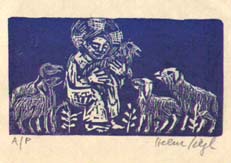 MONKS
and the LAND
MONKS
and the LAND MONKS
and the LAND
MONKS
and the LAND
From its first years Mt. Saviour has been associated with a farm
and to this day, the monastery appears agricultural. To a visitor
climbing
the monastery ravine out of Hendy Hollow, the first view of the
monastery
land is the sight of the long, terraced pastures sweeping up the hill
to
the east, these days often speckled with sheep...
By th late 1970's the modest beginning of a few dairy cows had grown into a modern, efficient dairy operation, possessing enormous assets in barns, machinery and a prize Holstein herd that was the top producer in the county. Yet, like so many modern agricultural success stories, the Mt. Saviour farm was at the mercy of the price of fossil fuels, feed grains, fertilizers, machinery, and the continuation of price supports amidst a huge food surplus. Further, the hill-side monastery fields were constantly pressed into service to raise grain - a purpose for which they were ill-suited - and the strain of manning the dairy bore heavily on the small monastic community. Finally, in 1981 the dairy was sold and it seemed that Mt. Saviour would join the ranks of most other Benedictine monasteries in this country that have abandoned farming in the past generation.
However, after reflection and discussion, the monks decided that they wished to use their land in an ecologically healthy manner that would be suited to the land itself and to the men who live on it. The fields surrounding the monastery are best suited to be pasture-land producing crops of grass and legumes while retaining a cover to protect the soil. The solution was to switch to the animal that survives best on a diet of grass and legume: sheep.
A large part of the Mt. Savior flock consists of Scottish Blackface sheep, a small hardy, rugged animal (even the ewes have horns), native to the highlands of Scotland and well adapted to a cold, damp climate, able to live outside in winter tolerating the extremes of climate and meager nutrition found in mountainous terrain, carrying a coat of warm, coarse wool that in winter grows almost down to its feet.
The second type of sheep on the farm consists of a small number of Blueface Leicester rams. A larger, less hardy sheep than the Blackface, the Blueface is a native of the hill sides of the English midlands. It is more prolific, has a finer fleece and its larger frame carries more meat than the Blackface. Animals that are a cross between the two pure breeds display what is called "hybrid vigor" displaying many of the best traits of both breeds. So half the flock consists of ewes produced by crossing the Blueface rams and the Blackface ewes, producing an animal called a Scottish Mule with distinctive high-pointed ears. Since 1994, the Scottish Mule ewes are bred to a Texel ram to produce "market lambs".
Ecological concerns played a large role in the design of the present farm. Mindful of world food problems and the disproportionate amount of feed grains used to produce meat for the American diet, the sheep chosen for the Mt. Saviour farm live entirely on a diet of grass and legumes. Using a breeding system in which the normal reproductive cycle of the sheep is respected - rutting in late autumn, lambing in early spring - keeping the animals outside in their natural habitat where they are least prone to disease and where the land is fertilized and built up by the very animals it supports, the Mt. Saviour farm is designed to best utilize the qualities of its land, its animals and the men who farm it in a manner that conserves resources for the future.
A question we are frequently asked is why monks, who devote themselves to "spiritual" lives of prayer, remain in farming. There is a pointed economic inquiry here, if the proceed of the sale of the dairy farm in 1981 had been invested would have produced a higher return than has the sheep farm. The answer to why we continue the farm is not rooted simply in economic concerns, it is also rooted in our spirituality, in a willingness to do humble work, and in a respect and care for the land. Every day at mass we bring to our altar for consecration gifts of bread and wine sprung from the soil beneath our feet. Our spirituality, if healthy, must seek both a love for the brothers and sisters who share this food and for the natural environment that produces it. In these days it is urgent for all people to learn to respect and nurture the earth from which we spring. The community of Mt. Saviour merely participates in this responsibility of all people to give liturgical praise to God, to live in a community of fraternal love and to be in a healthy relationship with the physical environment though which God creates and sustains us.
Written by Br, Nathan Munsch
Mittens made by Br. Pierre: $11.90 to $14.90 (small, medium or
large)
Other items are available. Please contact
231 Monastery Rd.
Pine City NY 14871
Fax: 607 734-1689
Br. Pierre & Br. Bruno with Scottish Blackface lamb and ewe.
Cover photo from the SHEEP Magazine, June 1994

Scottish Blackface ewes and Greyface ewe
Mount Saviour home page
Revised 10/20/00 Bruno.ms@Juno.com to contact Br. Bruno in charge of marketing